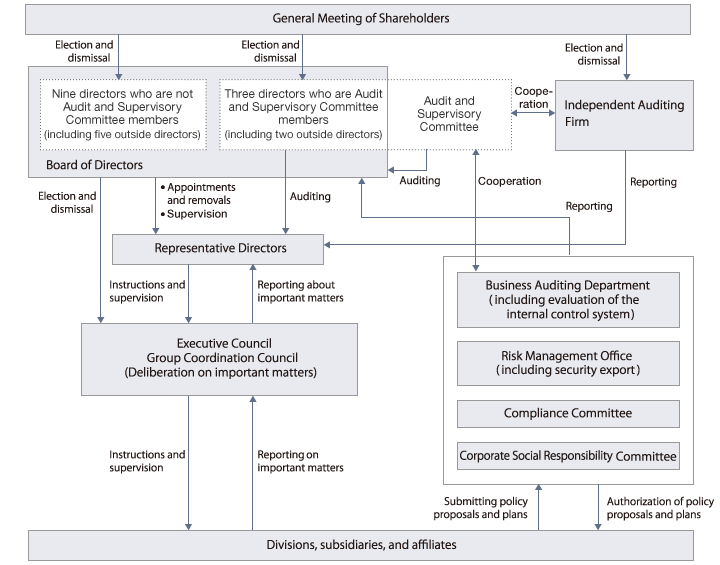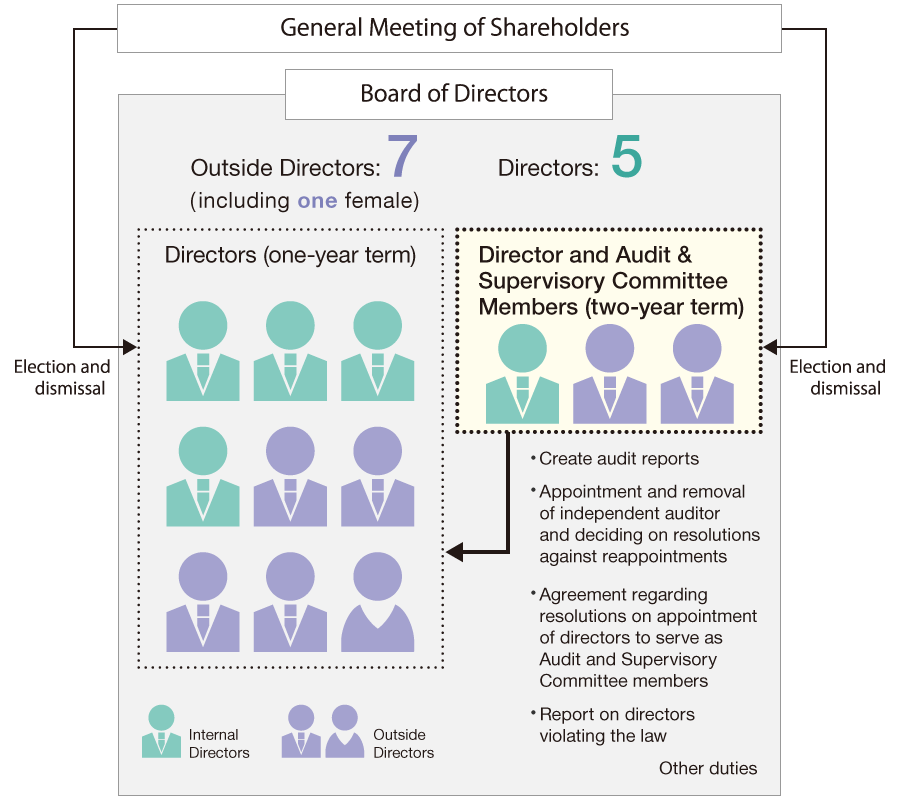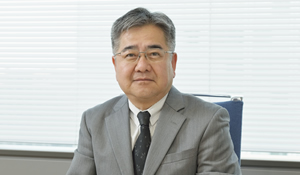
The USHIO Group recognizes that realizing the vision set forth in its Management Philosophy and promoting sustainable growth of the Company and increasing corporate value over the medium to long term will bring satisfaction to all stakeholders. In order to achieve this goal, the Company strives to ensure the transparency and efficiency of corporate management and to reinforce corporate governance for realizing speedy and resolute decision making.
At the Annual General Meeting of Shareholders on June 29, 2016, USHIO transitioned from a company with an audit & supervisory board structure to a Company with Audit and Supervisory Committee. The aim was to further strengthen the supervision function of the Board of Directors as part of a drive to reinforce corporate governance in order to ensure transparent and efficient corporate management and speedy and resolute decision-making.
This transition will foster speedy decision making by delegating decisions for certain important business matters from the Board of Directors to executive directors. It will also strengthen the supervision function of the Board of Directors by ensuring that most of its members are outside directors. The new setup will also reinforce audit and supervision functions by establishing an Audit and Supervisory Committee with the authority to assess the legality and validity of board members in performing their duties.
The Board of Directors comprises 12 directors. Nine are not Audit and Supervisory Committee members (including five outside directors) and three are Audit and Supervisory Committee members (including two outside directors). The Board of Directors oversees decision-making and business execution for top priority issues, including basic management policy.
Delegating decisions on certain important business execution to overseeing directors has accelerated decision-making. At the same time, the executive officer system has led to more accurate and speedier business execution. USHIO established the Executive Council and Group Coordination Council to discuss and report on priorities in business execution.
The Audit and Supervisory Committee which comprises three directors (including two outside directors) audits and oversees directors' performance of duties in line with its own audit and supervising standards. USHIO appointed a full-time Audit and Supervisory Committee member to enhance the efficacy of audits by collecting information from directors (excluding those who are also Audit and Supervisory Committee members) and employees and coordinating smoothly with the Internal Audit Department and independent Auditing Firm.

USHIO is reinforcing its corporate governance in line with the Corporate Governance Code of the Tokyo Stock Exchange. While it has yet to comply with the Supplementary Principle covering the analysis, evaluation, and disclosure of the Effectiveness of the Board of Directors, the Company recognizes the need to assess this area.
See the Corporate Governance Report for more details.
USHIO added three independent outside directors and three independent outside Audit and Supervisory Board members, and put in place a Remuneration Advisory Committee which consists of a chairperson and members with outside director comprising the majority in keeping with efforts to reinforce corporate governance.
USHIO has transitioned to a Company with Audit and Supervisory Committee structure to strengthen the supervision function of the Board of Directors and foster speedy decision-making by delegating judgments on certain important business matters to executive directors and executive officers.
After the transition, the Company has an Audit and Supervisory Committee comprising at least three directors of whom a majority are outside directors.
USHIO appointed a full-time Audit and Supervisory Committee member to enhance the efficacy of audits by collecting information from directors (excluding those who are also Audit and Supervisory Committee members) and employees and coordinating smoothly with the Internal Audit Department and independent Auditing Firm.


In line with its transition to a Company with Audit and Supervisory Committee structure, USHIO has chosen the majority of its directors externally and reinforced supervision functions by obtaining valuable advice and guidance relating to corporate management from the outside directors. The Company has accelerated decision-making on business execution by delegating authority to executive officers. It also focused more on execution ability in selecting the directors.
Broadly assuming that the Audit and Supervisory Committee focuses on compliance and safeguarding corporate value, one new audit point to be focused on is assessing the validity of business execution. The Audit and Supervisory Committee considers it important to help enhance corporate value through corporate governance, and looks to help improve management transparency and efficiency, foster speedy business execution, and ensure thorough risk management and compliance.
USHIO celebrated its 50th anniversary in 2014. The Company will pursue further growth by continuing its discussion on how best to commercialize high-value-added businesses and products.
The remuneration system comprises monetary compensation and stock-based compensation consisting of a basic amount based on position and an amount determined based on operating performance and performance evaluation. Resolutions by the Board of Directors regarding remuneration are reached based on deliberation conducted in advance by the Remuneration Advisory Committee, which consists of a chairperson and a majority of outside director members. This composition is from the perspective of ensuring fairness and appropriateness regarding the remuneration system and standards and the assessment of contribution to the Company's operating performance.
| Director categories | Total remuneration and other payments (millions of yen) | Total amounts types of remuneration and other payments (millions of yen) |
Number of eligible directors | ||||
|---|---|---|---|---|---|---|---|
| Basic compensation | Stock options | Bonuses | Stock-based compensation for directors | Retirement benefits | |||
| Directors (excluding outside directors) | 366 | 292 | - | - | 73 | - | 9 |
| Audit and Supervisory Committee members (excluding outside members) | 25 | 25 | - | - | - | - | 3 |
| Outside directors | 36 | 36 | - | - | - | - | 7 |
The Internal Audit Department performs on-site audits to check the appropriateness of operational controls and procedures. The department submits an annual audit plan to the Audit and Supervisory Committee and explains its specific auditing policies. It also reports as necessary to the committee on the results of internal audits.
The Independent Auditor submits annual plans to the Audit and Supervisory Committee and explains its specific auditing policies. It also presents reports summarizing reviews and audit results for quarterly reviews and accounting audits for quarterly and year-end results.
The Audit and Supervisory Committee, Internal Audit Department and independent auditor exchange information and opinions and cooperate with each other.
USHIO has established “10 Action Guidelines” in order to define standards for behavior that require everyone at the Group to comply with laws, regulations, the Articles of Incorporation, and management philosophy. The Compliance Committee is responsible for ensuring that employees observe these guidelines. The Business Auditing Department and Compliance Committee jointly perform audits to monitor the status of compliance and submit audit reports as necessary to the Board of Directors and Audit and Supervisory Committee. Furthermore, information involving the performance of directors' duties is recorded, stored, and managed, in documentary and electronic formats. This enables the directors and Audit and Supervisory Committee members to view the information at any time and take timely and appropriate action as required.
To reinforce awareness of the importance of compliance, all Group companies use USHIO's standards for behavior and other guidelines and the Business Auditing Department performs audits of the Group companies.
In its risk management regulations, USHIO has specified departments responsible for respective risk categories, including compliance, the environment, product quality, finance, legal matters, natural and other disasters, information management, and export controls. Each responsible department is to establish rules and guidelines, conduct training, and produce and distribute manuals and so forth. When a new risk emerges, a director or an executive officer is to be promptly appointed to take responsibility for handling it. Furthermore, if a risk materializes and is expected to incur significant damage, the responsible director or executive officer is to report it promptly to the Board of Directors.
USHIO acquires and holds a variety of information in the course of conducting its business operations. We are well aware of the importance of safeguarding information about customers and suppliers, personal information, confidential business information and other important information, and have established rules for the proper handling of this information. There are stringent requirements concerning the protection of confidential information, whether the information is internal or related to a customer or business partner. Another priority is compliance with Japan's Personal Information Protection Law. To reinforce everyone's commitment to complying with this law and ensure its effective enforcement, all USHIO departments use a cycle of self-assessments to determine the status of compliance and carry out continuous improvements based on these assessments.
IC cards are one way that the USHIO protects information. We use these cards to keep track of when employees enter and leave particular rooms and record their working hours. IC cards restrict access to sensitive areas and keep records of when employees enter these areas, which helps prevent unauthorized access to important information. Using servers for the centralized oversight of computer software assets and computer virus protection is another measure that protects information, which upgrades our ability to manage information while reducing the amount of time and resources needed. For confidential information received from customers and business partners, we have regulations covering every step from the receipt and storage of information to its ultimate disposal and perform periodic checks of the system. Customers and business partners perform on-site confirmations of our information security measures. We study the results of these confirmations to reexamine and reinforce information security measures and how they are used.